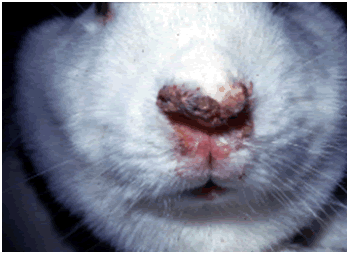Etiology: Treponema paraluis-cuniculi is a Gram-negative spirochete related to the human syphilis organism, Treponema pallidum.
Transmission: Venereal transmission is the most common mode of transmission in breeding colonies with males and females being equally affected. The bacteria can also be transmitted from animals with cutaneous lesions. Nursing and young rabbits appear resistant to infection.
Incidence: The incidence of disease is rare in research animals.

Clinical Signs: Subclinical infections are common. Cutaneous lesions may be present on external genitalia, anus, muzzle, and eyelids. Erythema, edema, and papules at mucocutaneous junctions are early lesions followed by ulcers with epidermal proliferation and crust formation. Lesions can persist for extended periods (>5 mo). Reluctance to breed and decreased reproductive efficiency may occur.
Pathology: Epidermal hyperplasia with erosions, ulcers; infiltrates of plasma cells, heterophils and macrophages. Spirochetes can be demonstrated in epidermis and dermis with silver stains. Lymphoid hyperplasia in regional lymph nodes may be seen.
Diagnosis: Diagnosis can be confirmed by scraping the skin lesion and examining a wet-mount with dark-field microscopy for characteristic morphology (spirochetes measure 6-15 µm by 0.1-0.2 µm) and motility (longitudinal rotation and flexion). Lesions can be biopsied and the organism can be identified on silver-stained sections. Serologic assays using Treponema pallidum as the antigen may be used for diagnosis, PCR may also be used.